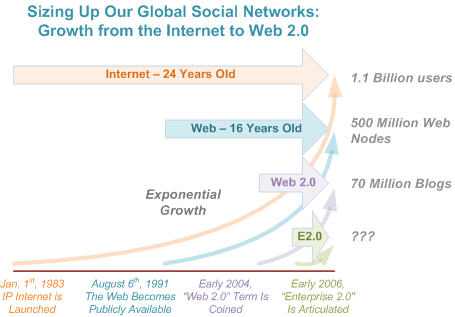It’s the second day of the Enterprise 2.0 Conference here at the Boston waterfront. Yesterday was the workshop day for the event as well as the much-ballyhooed showdown between Andrew McAfee and Tom Davenport, the original point of disagreement around the real impact of Enterprise 2.0 which I’ve covered before . Today the main conference sessions begin and a quick look at the show program tells you that an all-star cast of Enterprise 2.0 folks has been assembled here.
I was fortunate enough to be able to provide one of the morning workshops yesterday, an Intro to Social Computing, which I billed as a panoramic tour of the concepts and platforms of Web 2.0 and Enterprise 2.0 as well as a look at the organizing principles around how to create a strategy around them for your organization. If you weren’t able to make it, Doug Cornelius has done a great job blogging a rather detailed summary of the session, which seemed to be quite popular with the audience overall.
The big debate between McAfee and Davenport yesterday can now be viewed on video on Veodia. I missed it personally since it ran during my workshop session, but by all accounts it was an informative debate, even if some felt that violent agreement frequently took place. You can read good coverage of debate here from Andrew McAfee, ZDNet’s Dan Farber (who moderated the debate), and John Eckman, the latter which has a detailed transcript. For those of you who don’t know it, Andrew McAfee is the Harvard Business School professor that defined the concept of Enterprise 2.0 last year. If you’re trying to get a handle on all this, I definitely recommend that you watch the video of the debate or the first episode of our Enterprise 2.0 TV Show.
Is Web 2.0 Really Moving to the Workplace?
I’m a big believer in using measurable numbers to define the scope and importance of trends online. One thing I often do in my of my talks on Web 2.0 is to ask the audience to raise their hand if they have an easy to way to create a blog or wiki on their local Intranet. Last year at the Collaboration Technologies Conference (the event that was renamed this year to the Enterprise 2.0 Conference), I asked the question and just a handful of people raised their hand. Yesterday, in a crowd of around a hundred, about 10-15% raised their hand. Compared to the same question I ask audiences about LinkedIn usage (which have gone from that same handful last year to nearly 70%), and it’s a telling indicator of how enterprises are lagging behind in adoption of these tools.
Andrew McAfee has described the SLATES mnemonic (details on it here) to capture the essential elements of an Enterprise 2.0 platform. The “A” in SLATES stands for Authorship, in that if workers don’t have the ability to publicly author material that the rest of the organization can find, use, and otherwise leverage, then these tools simply won’t be effective. Authorship is Step One in capturing the otherwise hidden and lost knowledge that is the submerged “iceberg” of information that is still not kept in the IT systems of a typical organization (i.e. “tacit instituational knowledge). And my informal surveys over the last year have shown little practical growth here.
The bottom line is that the Enterprise 2.0 story has a long way to go and we aren’t going to see the results until the tools get into most worker’s hands and organizations understand the key elements of success with Enterprise 2.0. Fortunately, the grassroots side of the Enterprise 2.0 story is quite good and informal data there suggests that workers are bringing these tools in to their organizations on their own when they’re not being provided for them. This has positive and negative ramifications both but it does indicate that E2.0 has serious momentum on the ground on its own.

In my diagram above, I depict the growth of the Internet and various new stages of it, including Web 2.0, which I often say that Tim Berners-Lee gave us, but we didn’t get at first. I put it together to show how each new development grew exponentially, unlike many of the other aspects added to it (things like Gopher for example). Network effects for these extensions of the Internet (the Web and Web 2.0) have indeed been exponential in terms of growth and adoption, but Enterprise 2.0 does not fit nicely onto this Internet extension model. This is because in practice Enterprise 2.0 presence will be highly fragmented since its implementations will exist just as much on private IP networks inside firewalls as well as on the open Internet, and often bridge them as well.
So how do we measure the growth of Enterprise 2.0? That will be one of the toughest questions as we try to figure out what’s really happening with Web 2.0 platforms in the enterprise. There’s little question however that it’s become a major trend on its own, whether we give it a name or not. For example, Wiki platforms have already begun proliferating inside most organizations, and so too with blogs, and other Enterprise 2.0 platforms.
How do you think we should measure Enterprise 2.0’s growth?
Editorial Note: This is my inaugural blog post as the new Editor-In-Chief of Social Computing Magazine. I’ve retired as EiC of the Web 2.0 Journal and AjaxWorld Magazine and have accepted Jeremy Geelan’s gracious invitation to help head up this highly informative online exploration on the application of Web 2.0 and social software to business, society, and culture. Stay tuned here at the Web 2.0 Blog for lots more and please do drop me a line and let me know what you’re doing in the Web 2.0 and Enterprise 2.0 communities.
